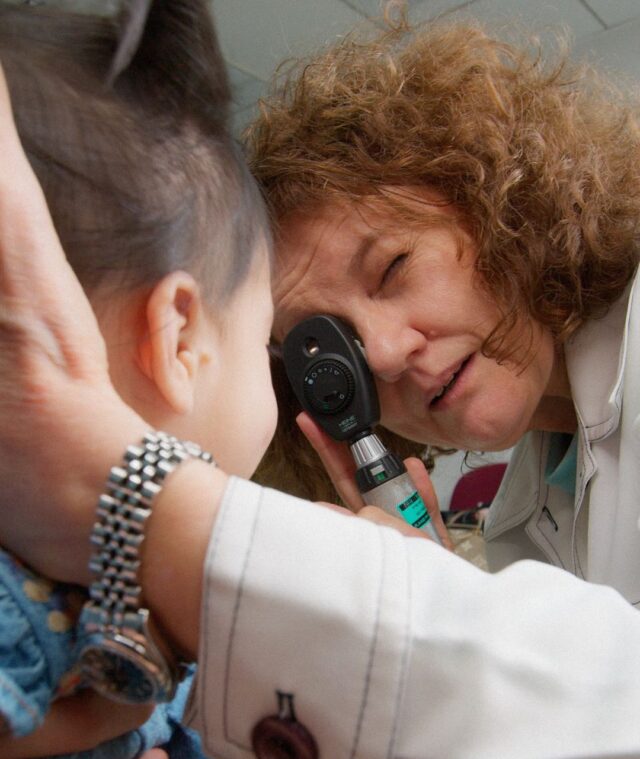As pediatric ophthalmologists in Dubai, we have many parents entrusting us with their children’s eye health. Often, parents ask for us advice on how they can best protect and care for their children’s vision.
Here are five tips we offer.
1. Know that not all vision problems are obvious
You may feel that your child has good vision. They may have no problems spotting small items, reading books, or seeing what’s written on the teacher’s board. However, these are not proof that your child’s vision is problem-free.
A child’s brain is capable of learning to accommodate and compensate for eye problems, thus the underlying eye problem is often disguised. However, this does not mean these problems should go unaddressed.
Undiagnosed eye health problems can affect a child’s academic achievement, social life, and emotional health. With an undiagnosed eye health issue, your child may:
- Become easily fatigued
- Get frequent headaches
- Struggle to concentrate on schoolwork or reading
- Struggle to remember information from texts
- Lose interest in school or cease to enjoy attending
Undetected vision problems can, therefore, seriously affect a child’s ability to reach their potential despite evident capabilities.
Here are some examples of serious vision problems that can easily go undetected:
- Amblyopia is a condition where the brain learns to ignores images from the weaker or turning eye, or anone eye that is out of focus compared to the other (uneven focus correction) and only presents fuzzy images to the visual memory. It is also called “Lazy Eye” and can become permanent if left untreated past visual maturity, yet is easily treated if found early enough. Usually, providing the appropriate correction in glasses, and then wearing an eye patch over the better-seeing eye for a monitored period of time, can successfully treat amblyopia.
- Small squints/crossed (inward) or drifting/lazy (outward) cause misalignment and eye strain.
- Refractive errors like nearsightedness (myopia), farsightedness (hyperopia) and astigmatism often go unnoticed until an eye exam.
2. Ensure your child gets regular eye exams
The only way to be sure that your child’s eyes are healthy is to regularly attend eye exam appointments. This gives your ophthalmologist a chance to identify problems and treat them quickly before they potentially become more serious.
How often your child is asked to attend will depend on their age (for example, infants should be screened more often) and any additional risk factors unique to your child. This may include a personal or family history of eye problems, a premature birth, or certain medical conditions such as diabetes.
Low-risk school-age children are often invited bi-annually, but you should always follow the schedule advised by your family eye doctor to ensure the best outcomes.
A comprehensive eye exam includes screening for the following conditions:
- Amblyopia (as explained above)
- Ptosis is a drooping of the upper eyelid that might cover the pupil
- Strabismus, a condition that often presents as “crossed eyes”
- Refractive errors like nearsightedness (myopia), farsightedness (hyperopia) and astigmatism
3. Be aware of the dangers to eye safety at home
Parents need to be aware of the potential for accidents to cause damage to their children’s eye health. Every year, thousands of children experience accidents that affect their vision, some of which cause permanent damage.
Many childhood eye injuries happen at home. These could be caused by falls, knocks or bangs, or foreign bodies or substances entering the eye.
Very often, parents could have taken simple steps that would have eliminated the risk of an accident. Here are a few tips to make your home more “eye-safe”:
- Use gates on stairs until you have taught your child to use the stairs safely without being supervised.
- Keep floors tidy and free from items you or youra child could slip on or trip over.
- Cushion sharp corners of furniture, if possible.
- Always keep household cleaning and laundry products out of reach. Toiletries can also pose a danger.
- Make sure toys are age-appropriate and that your child is supervised using toys with small, detachable or protruding parts. Injuries from toy guns are common, so teach your older child how to use these sensibly to lower the risks to their own eyes and others’ eyes.
- Teach your child the dangers of throwing items around.
- Set a good example by always wearing eyewear yourself when completing any task that poses a danger to your eyes.
4. Provide eye protection for sports
Taking part in sports is vital for children’s physical health. However, sports do pose a danger to your children’s eyes so it’s important to provide the appropriate eye safety wear.
The American Academy of Ophthalmology states that an ER treats sports-related eye injuries once every 13 minutes in the US alone. One in three of these 100,000 injuries per year involves a child’s eyesight. It is also believed that 90% of these accidents could have been prevented by the correct safety eyewear.
While many sports eye injuries are caused by bats and balls, many others are caused by collisions, falls or accidental pokes by fingers or equipment. This means that eyewear should be worn for most sports.
Your child’s teacher or qualified coach should be able to advise you on the right eyewear for the sport. When purchasing their recommendations, be sure that the eyewear has the appropriate safety certification. Lenses should be made of shatterproof polycarbonate.
5. Check on screen time
Kids love to play games on their devices, message their friends, watch YouTube and more, as it was made available to them – initially to help with boredom, perhaps? However, many parents are worried about the effects that too much screen time will have on their child. One of their concerns is their child’s eyesight, not to mention the social isolation, instant gratification and reduced self-regulation it brings, and blunting inherent initiative.
Digital eye strain
Kids can experience all the symptoms of digital eye strain, just as adults do. After long periods of looking at a screen, your child may experience headaches, dry eyes and blurred vision. These effects are unpleasant, but usually temporary.
To prevent digital eye strain, make sure your child doesn’t use their device for more than 20 minutes without taking a break, even during web-based home-schooling.
Screen time and myopia
Eye doctors are increasingly worried about the rise of rapidly progressing myopia (nearsightedness). In Asia, as many as 90% of teenagers and adults are now myopic. For a long time, scientists have suspected a link between near-work (i.e., computer work, reading books, or small screen device use) and myopia.
One thing that does seem very clear is that spending more time outdoors in childhood (and therefore less time in near-work) slows the progression of myopia. This has been proven across several studies.
With this knowledge in mind, it does seem sensible to encourage children to develop healthy habits with screen time — to not play too frequently or for too long, and to spend plenty of time in outdoor interactive active play with siblings or friends, wherever possible, instead.
By following these five tips, you should feel confident that you are doing your best to maintain your child’s good eye health, and that any problems will be quickly spotted and treated by your ophthalmologist before they become severe.
Visit our team of eye specialists today to learn more about maintaining your child’s eye health.








